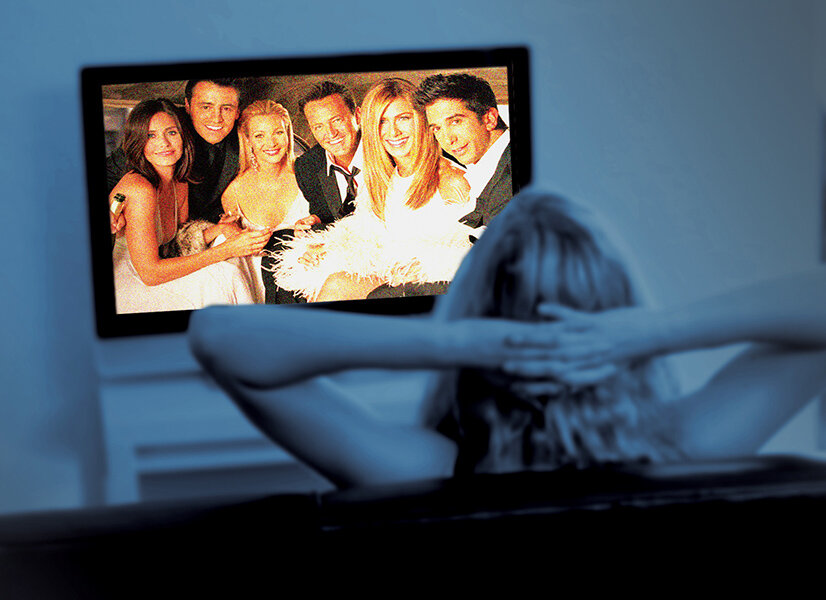My daughter’s ‘Friends’
Loading...
Two weeks. That’s how long it took my 13-year-old to stream all 10 seasons of “Friends.” It took me an entire decade to watch them.
Curtailing my daughter’s binge watching might have been the more prudent parenting choice, but that would have been hypocritical. Few things are more intoxicating than the appearance of the “next episode” button. This is especially true for those of us who remember when watching a favorite TV show was a study in loyalty and logistics.
During the original run of “Friends,” beginning in 1994, my two sisters and I had a standing Thursday night date to watch each new episode – from theme song to credits – as it aired. With a 7 p.m. start time, making this rendezvous wasn’t easy.
Without Google Maps, smartphones, and Siri, we relied entirely on our savvy and street smarts to get us to the TV on time, takeout in tow. Heart rates surged as we endured traffic jams, sluggish mass transit, and the occasional blizzard. With no time to spare, we’d double-park, risking pricey tickets as we nervously waited for our order at our favorite sushi place.
When the three of us were, at last, assembled, we’d click on the TV and breathe a collective sigh of relief. And yet, tension lingered. History had shown that our meticulous plans could be upended: a ringing landline that could not be silenced or ignored (What if it’s Mom?), an interruption for breaking news (Now? Really?), a spicy tuna roll missing from an order. Worst of all was the appearance of a spouse who did not respect the sanctity of silence. His uninvited commentary might drown out a key piece of dialogue (“We were on a break!”). With no pause button, no rewind, no next-day viral video, there was only the interminable wait for summer reruns.
My daughter’s “Friends” experience was considerably less harrowing. She got dressed, snacked, and brushed her teeth accompanied by Rachel, Ross, and the gang. When life interrupted in the form of school or extracurricular activities, she’d groan, reluctantly press pause, and then seamlessly resume once her schedule permitted. Her only real challenge was announced with a blood-curdling scream when buffering interrupted her viewing bliss.
“I can’t wait to see what happens at Ross’s wedding,” my daughter said one day as we ran errands, her eyes glued to her cellphone screen. Seconds later, she was watching the nuptials unfold while I silently fumed at the ease with which she transitioned from one precious episode to the next. She was greedily devouring a meal that I’d slowly savored.
Am I a better, more patient, morally superior person because I had to endure months of anxious anticipation before finding out what happened after Ross inadvertently said Rachel’s name during his vows to Emily? Hardly. Given a screen and the ability to stream, I’d have done little else with my childhood. Still, I can’t help feeling that my daughter has missed out on essential aspects of my TV-watching experience: Anticipation. Urgency. Marking the passage of time.
In the decade that “Friends” aired, the characters, the actors who portrayed them, and the story lines evolved slowly, as did we. Our jeans dropped from high waist to hip, sweaters shrank, and shoulder pads disappeared. New relationships, careers, and families formed. Technology and politics underwent seismic shifts. In the two weeks my daughter speed-watched, the weather barely changed. How vested could she truly be in Joey’s acting career, Monica’s desire for a baby, or Ross’s failed marriages? Can she comprehend the outsize societal impact of Rachel’s hairstyle or the heart-wrenching disappearance of the twin towers from the show’s cityscape background shots?
As transcendent as a film, a book, a song, or even a “silly” sitcom might have felt to me, it’s futile to expect it to resonate with my daughter. I can’t convey the zeitgeist anymore than I can defend the presence of Marcel, the monkey on Season 1.
My daughter, now on her second or third go-round, is creating her own relationship with “Friends.” The good news? We’ve bonded over our shared, if not identical, love for it. She vigorously states her opinions (“Monica is so bossy!”). I give mine (“Monica just wants things the way she wants them.”). She offers a refresher course on the importance of achieving a state of “Unagi.” I tell her back-in-the-day tales of my struggles to get sushi on “Friends”-watching Thursdays. She informs me that Phoebe’s twin sister, Ursula, was originally on a show called “Mad About You.” I feign surprise.
“I wish I lived in the ’90s,” my daughter said recently. “People sat around and actually talked instead of staring at their phones all the time. It seems like more fun.”
“Yup, those were the good old days,” I said, her perspective a welcome surprise. “Talk, talk, talk, that’s all we did.” Except, that is, when we were scrambling to get to the TV on time.







